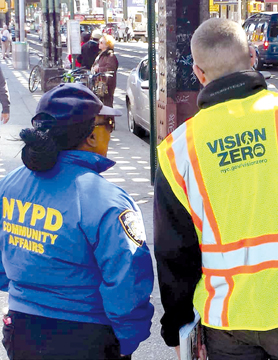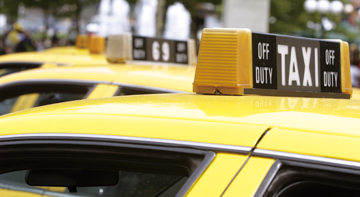
TLC OUTLINES CONTINUING
VISION ZERO EFFORTS
This is an update on what the TLC has accomplished to further the Mayor's
Vision Zero goal, and our continued efforts to keep the City's streets safe for all.
The New York City Taxi and Limousine Commission (TLC) highlighted a year of progress in its efforts to support Mayor Bill de Blasio's Vision Zero Action Plan. As one of three lead Vision Zero agencies, alongside the NYPD and NYC DOT, the TLC's role is to enhance the safety of the taxicab and other for-hire industries it regulates through effective regulations, communication, education, and new technology. The TLC also laid out its pathway to building on the successes of its "Vision Zero Year Two" with an even busier year ahead.
"The TLC is fortunate to have a dedicated staff, and a safety conscious group of industry leaders and drivers to work with," said TLC Commissioner and Chair Meera Joshi. "We have surpassed even our own expectations of the number of drivers we've reached with our messages this past year, but we still have a long way to go and hard work ahead of us to reach Vision Zero."
Commissioner Joshi also emphasized a message to passengers, namely "Tell your drivers that safety and NOT speed is your priority, and make it clear that you tip for safety."

About the NYC TLC: The New York City Taxi and Limousine Commission (TLC) was created in 1971, and is the agency responsible for the regulation and licensing of over 200,000 yellow medallion taxicabs and for-hire vehicles, their drivers, and the businesses that operate and support their industries. It is recognized as the largest and most active taxi and limousine regulatory body in the United States. To find out more about the TLC, or to review its rules and procedures, we encourage you to visit our official Web site at www.nyc.gov/taxi or contact 311/311 Online.
Industry Notice #16-07, March 09, 2016
Update to Industry Notice #15-59
Med/FHV License Expanded to Include FHV Drivers
Licensed Since March 1, 2014
To increase room for mobility between sectors, income opportunities for drivers and to further streamline the licensing process, the TLC is transitioning to a combined MED/FHV license.
For existing medallion drivers, upon your renewal you will automatically receive a Med/FHV license that will serve as the appropriate credentials whether you are driving a Medallion or an FHV.
For new Medallion drivers, your new license will be a Med/FHV license.

Experienced For-Hire Vehicle (FHV) drivers, who have held a license since March 1, 2014 or longer, are also now eligible to request a Med/FHV license through a testing procedure that will be available in 2016.
The TLC will temporarily allow Agents and Medallion Owners to work with experienced FHV drivers who want to drive a yellow taxi until the test is available in 2016.
Agents or Medallion Owners interested in working with experienced FHV drivers are invited to participate in the following pre-test process:
Step 1: Identify the drivers who are interested in a Med/FHV license by sending the TLC a list with the following information for each driver:
A. Driver's name;
B. FHV license number;
C. Agent/Owner Certification, in accordance with TLC rules prohibiting the filing of false information, that the drivers are:
i. Trained on how to operate the T/LPEP meter and that the meter must be engaged for ALL trips in any medallion and Street Hail Livery vehicle regardless of how the trip was arranged; and are trained in the use of accessible vehicle equipment;
ii. Proficient in English;
iii. Fully understand the fare and refusal rules.
Step 2: The TLC will review the certification and the FHV driver's TLC history.
Step 3: If the TLC confirms that the driver has completed the form, that the license is current and valid, and that the length of the license term meets the requirements. The driver will be given a conditional Med/FHV license until the Med/FHV license test is made available in 2016.
Drivers in this category will be given 60 days from the introduction of the test to successfully pass it and thereby receive a permanent Med/FHV license. An Industry Notice will be published when the test is made available in 2016.
Once the Med/FHV license test is available, FHV drivers who qualify will be required to complete the test in order to receive a permanent Med/FHV license to drive a yellow taxi and will not require certification by an Agent or Medallion Owner.